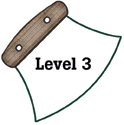|
National Science Education Standards
Use appropriate tools and techniques to gather, analyze, and interpret
data. The use of tools and techniques, including mathematics, will be
guided by the question asked and the investigations students design. The
use of computers for the collection, summary, and display of evidence
is part of this standard. Students should be able to access, gather, store,
retrieve, and organize data, using hardware and software designed for
these purposes. (Page 145)
Develop descriptions, explanations, predictions, and models using evidence.
Students should base their explanation on what they observed, and as they
develop cognitive skills, they should be able to differentiate explanation
from description-providing causes for effects and establishing relationships
based on evidence and logical argument. This standard requires a subject-matter
knowledge base so the students can effectively conduct investigations,
because developing explanations establishes connections between the content
of science and the contexts within which students develop new knowledge.
(Page 145)
Think critically and logically to make the relationships between evidence
and explanations. Thinking critically about evidence includes deciding
what evidence should be used and accounting for anomalous data. Specifically,
students should be able to review data from a simple experiment, summarize
the data, and form a logical argument about the cause-and-effect relationships
in the experiment. Students should begin to state some explanations in
terms of the relationship between two or more variables. (Page 145)
Communicate scientific procedures and explanations. With practice, students
should become competent at communicating experimental methods, following
instructions, describing observations, summarizing the results of other
groups, and telling other students about investigations and explanations.
(Page 148)
Use mathematics in all aspects of scientific inquiry. Mathematics is
essential to asking and answering questions about the natural world. Mathematics
can be used to ask questions; to gather, organize, and present data; and
to structure convincing explanations. (Page 148)
Mathematics is important in all aspects of scientific inquiry. (Page
148)
Technology used to gather data enhances accuracy and allows scientists
to analyze and quantify results of investigations. (Page 148)
|
|
Benchmarks
If more than one variable changes at the same time in an experiment,
the outcome of the experiment may not be clearly attributable to any one
of the variables. It may not always be possible to prevent outside variables
from influencing the outcome of an investigation (or even to identify
all of the variables), but collaboration among investigators can often
lead to research designs that are able to deal with such situations. (Page
12)
|


